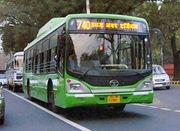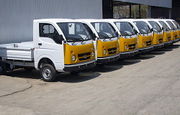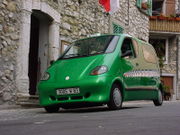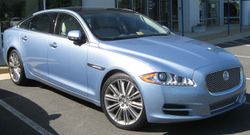Tata Motors
| Type | Public (BSE: 500570) (NYSE: TTM) |
|---|---|
| Industry | Automotive |
| Founded | 1945 |
| Founder(s) | JRD Tata |
| Headquarters | Mumbai, Maharashtra, India |
| Key people | Ratan Tata, Chairman Ravi Kant, Vice Chairman Carl Peter Foster, CEO Prakash Telang, MD (India Operations) Ravi Pisharody, President (CVBU) |
| Products | |
| Services | Outsourced Engineering and Design |
| Revenue | $14.250 billion (2009) |
| Operating income | $10.40 billion (2009) |
| Net income | $1.198 billion (2009) |
| Total assets | $15.430 billion (2009) |
| Total equity | $763 million (2009) |
| Parent | Tata Group |
| Subsidiaries |
|
| Website | TataMotors.com |
Tata Motors Ltd (NSE: TATAMOTORS, BSE: 500570, NYSE: TTM) is a multinational corporation headquartered in Mumbai, India. Part of the Tata Group, it was formerly known as TELCO (TATA Engineering and Locomotive Company). Tata Motors has a consolidated revenue of USD 16 billion after the acquisition of British automotive brands Jaguar and Land Rover in 2008.
It is India's largest company in the automobile and commercial vehicle sector with upwards of 70% cumulative market share in the domestic commercial vehicle segment, and had a 0.81% share of the world market in 2007 according to OICA data. The OICA ranked it as the 19th largest automaker,[1] based on figures for 2007.[2] and the second largest manufacturer of commercial vehicles in the world. The company is the world’s fourth largest truck manufacturer, and the world’s second largest bus manufacturer. In India Tata ranks as the leader in every commercial vehicle segment, and is in the top 3 makers of passenger cars. Tata Motors is also the designer and manufacturer of the iconic Tata Nano, which at INR 100,000 (ex-factory) or approximately USD 2300, is the cheapest production car in the world.
Established in 1945, when the company began manufacturing locomotives, the company manufactured its first commercial vehicle in 1954 in a collaboration with Daimler-Benz AG, which ended in 1969.[3] Tata Motors is a dual-listed company traded on both the Bombay Stock Exchange, as well as on the New York Stock Exchange. Tata Motors in 2005, was ranked among the top 10 corporations in India with an annual revenue exceeding INR 320 billion.
In 2004 Tata Motors bought Daewoo's truck manufacturing unit, now known as Tata Daewoo Commercial Vehicle, in South Korea. It also acquired Hispano Carrocera SA, now a fully-owned subsidiary. In March 2008, it acquired the Jaguar Land Rover (JLR) business from the Ford Motor Company, which also includes the Daimler and Lanchester brands.[4][5][6] and the purchase was completed on 2 June 2008.[7]
Tata Motors has auto manufacturing and assembly plants in Jamshedpur, Pantnagar, Lucknow, Ahmedabad, Sanand and Pune in India, as well as in Argentina, South Africa and Thailand.
Contents |
History
Tata Motors is a part of the Tata Group manages its share-holding through Tata Sons. The company was established in 1935 as a locomotive manufacturing unit and later expanded its operations to commercial vehicle sector in 1954 after forming a joint venture with Daimler-Benz AG of Germany. Despite the success of its commercial vehicles, Tata realized his company had to diversify and he began to look at other products. Based on consumer demand, he decided that building a small car would be the most practical new venture. So in 1998 it launched Tata Indica, India's first fully indigenous passenger car. Designed to be inexpensive and simple to build and maintain, the Indica became a hit in the Indian market. It was also exported to Europe, especially the UK and Italy. In 2004 it acquired Tata Daewoo Commercial Vehicle, and in late 2005 it acquired 21% of Aragonese Hispano Carrocera giving it controlling rights of the company. It has formed a joint venture with Marcopolo of Brazil, and introduced low-floor buses in the Indian Market. Recently, it has acquired British Jaguar Land Rover (JLR), which includes the Daimler and Lanchester brand names.[4][5][6]
Expansion

After years of dominating the commercial vehicle market in India, Tata Motors entered the passenger vehicle market in 1991 by launching the Tata Sierra, a multi utility vehicle. After the launch of three more vehicles, Tata Estate (1992, a stationwagon design based on the earlier 'TataMobile' (1989), a light commercial vehicle), Tata Sumo (LCV, 1994) and Tata Safari (1998, India's first sports utility vehicle). Tata launched the Indica in 1998, the first fully indigenous passenger car of India. Though the car was initially panned by auto-analysts, the car's excellent fuel economy, powerful engine and aggressive marketing strategy made it one of the best selling cars in the history of the Indian automobile industry. A newer version of the car, named Indica V2, was a major improvement over the previous version and quickly became a mass-favourite. Tata Motors also successfully exported large quantities of the car to South Africa.The success of Indica in many ways marked the rise of Tata Motors.[8]
Subsidiary Brands
|
Tata Novus is one of the best selling commercial trucks in South Korea.
|
Hispano Divo at the 2008 FIAA in Madrid
|

Range Rover
|
Tata Daewoo Commercial Vehicle
With the success of Tata Indica, Tata Motors aimed to increase its presence worldwide. In 2004, it acquired the Daewoo Commercial Vehicle Company of South Korea. The reasons behind the acquisition were:
- Company's global plans to reduce domestic exposure. The domestic commercial vehicle market is highly cyclical in nature and prone to fluctuations in the domestic economy. Tata Motors has a high domestic exposure of ~94% in the MHCV segment and ~84% in the light commercial vehicle (LCV) segment. Since the domestic commercial vehicle sales of the company are at the mercy of the structural economic factors, it is increasingly looking at the international markets. The company plans to diversify into various markets across the world in both MHCV as well as LCV segments.
- To expand the product portfolio Tata Motors recently introduced the 25MT GVW Tata Novus from Daewoo’s (South Korea) (TDCV) platform. Tata plans to leverage on the strong presence of TDCV in the heavy-tonnage range and introduce products in India at an appropriate time. This was mainly to cater to the international market and also to cater to the domestic market where a major improvement in the Road infrastructure was done through the National Highway Development Project.
Tata remains India's largest heavy commercial vehicle manufacturer and Tata Daewoo is the 2nd largest heavy commercial vehicle manufacturer in South Korea. Tata Motors has jointly worked with Tata Daewoo to develop trucks such as Novus and World Truck and buses namely, GloBus and StarBus.
Hispano Carrocera
In 2005, sensing an opportunity in the fully-built bus segment, Tata Motors acquired a 21% stake in Hispano Carrocera SA,[9] the leading European bus and coach cabin maker. In 2009, the company picked up the remaining 79% stake in Hispano Carrocera SA for an undisclosed sum, making it a fully-owned subsidiary.
Jaguar Cars and Land Rover
After the acquisition of the British Jaguar Land Rover (JLR) business, which also includes the Daimler, Lanchester and Rover brands,[10] Tata Motors became a major player in the international automobile market. On 27 March 2008, Tata Motors reached an agreement with Ford to purchase their Jaguar Land Rover operations for US$2 billion. The sale was completed on 2 June 2008.[7]
In addition to the brands, Tata Motors has also gained access to two design centres and two plants in UK. The key acquisition would be of the intellectual property rights related to the technologies.
Joint ventures

Tata Motors has formed a 51:49 joint venture in bus body building with Marcopolo of Brazil. This joint venture is to manufacture and assemble fully-built buses and coaches targeted at developing mass rapid transportation systems. The joint venture will absorb technology and expertise in chassis and aggregates from Tata Motors, and Marcopolo will provide know-how in processes and systems for bodybuilding and bus body design. Tata and Marcopolo have launched a low-floor city bus which is widely used by Chennai,Delhi, Mumbai,Lucknow and Banglore transport corporations.
Tata Motors also formed a joint venture with Fiat and gained access to Fiat’s diesel engine technology.[11] Tata Motors sells Fiat cars in India and is looking to extend its relationship with Fiat and Iveco to other segments. Tata has also formed several JV's with many small companies in various countries around the world.
Important developments
Tata Nano

In January 2008, Tata Motors launched Tata Nano, the least expensive production car in the world at about Rs. 100,000 (US $2,500).[12] The city car was unveiled during the Auto Expo 2008 exhibition in Pragati Maidan, New Delhi.[13]
Tata has faced controversy over developing the Nano as some environmentalists are concerned that the launch of such a low-priced car could lead to mass motorization in India with adverse effects on pollution and global warming. Tata has set up a factory in Sanand, Gujarat and the first Nanos are to roll out summer 2009.
Tata Nano Europa has been developed for sale in developed economies and is to hit markets in 2010 while the normal Nano should hit markets in South Africa, Kenya and countries in Asia and Africa by late 2009. A battery version is also planned.
Tata has also been approached by a province in France named Moselle to setup a Tata Nano manufacturing plant.
Tata Ace

Tata Ace, India's first indigenously developed sub-one ton mini-truck, was launched in May 2005. The mini-truck was a huge success in India with auto-analysts claiming that Ace had changed the dynamics of the light commercial vehicle (LCV) market in the country by creating a new market segment termed the small commercial vehicle (SCV) segment. Ace rapidly emerged as the first choice for transporters and single truck owners for city and rural transport. By October 2005, LCV sales of Tata Motors had grown by 36.6 percent to 28,537 units due to the rising demand for Ace. The Ace was built with a load body produced by Autoline Industries.[14] By 2005, Autoline was producing 300 load bodies per day for Tata Motors.
Ace is still a top seller for TML with 5M units sold to date (June 2010).[15]
Ace has also been exported to several European, South American and African countries and all-electric models are sold through Chrysler's Global Electric Motorcars division.[16]
Compressed air car

Motor Development International of France has developed the world's first prototype of a compressed air car, named OneCAT.[17] In 2007, MDI owner Guy Negre was reported to have "the backing of Tata".[17]
It has airtanks that can be filled in 4 hours by plugging the car into a standard electrical plug. In 2008 MDI planned to also design a gas station compressor, which would fill the tanks in 3 minutes.[18] There are no gasoline costs and no fossil fuel emissions from the vehicle when run in town, but "the compressed air driving the pistons can be boosted by a fuel burner".[18]
OneCAT is a five seat vehicle with a 200-litre (7.1 cu ft) trunk. With full tanks it is said to run at 100 km/h (62 mph) for 90 kilometres (56 mi) range in urban cycle. There are severe physical arguments pleading against those figures. In December 2009 Tata's vice president of engineering systems confirmed that the limited range and low engine temperatures were causing difficulties.[19]
Electric vehicles
Tata Motors unveiled the electric versions of passenger car Tata Indica and commercial vehicle Tata Ace. Both run on lithium batteries. The company has indicated that the electric Indica would be launched locally in India in about 2010, without disclosing the price. The vehicle would be launched in Norway in 2009.[20]
Tata Motors' UK subsidiary, Tata Motors European Technical Centre, has bought a 50.3% holding in electric vehicle technology firm Miljøbil Grenland/Innovasjon of Norway for US$1.93 M, which specialises in the development of innovative solutions for electric vehicles, and plans to launch the electric Indica hatchback in Europe next year.[21][22][23]
Operations

The Tata Safari DiCOR is one of Tata's best selling vehicles in India and also has been fairly successful in the Mediterranean and Eastern Europe
|

Tata has tried to revamp all its models in order to satisfy the consumer
|
|
The purchase of Jaguar and Land Rover is expected to help give Tata Motors gain a foothold in the European and American markets.
|

Tata relies on its subsidiaries for sales outside India. Seen here is the Range Rover Sport.
|

Tata Xenon is Tata's best selling vehicle in Europe.
|
Tata in India

Tata Motors Limited is India’s largest automobile company, with revenues of ![]() 35,651.48 crore (US$ 8.09 billion) in 2007-08.[24] It is the leader in commercial vehicles in each segment, and among the top three in passenger vehicles with winning products in the compact, midsize car and utility vehicle segments.[24] Tata Motors’ presence indeed cuts across the length and breadth of India. Over 4 million Tata vehicles ply on Indian roads, since the first rolled out in 1954.[25] The company’s manufacturing base in India is spread across Jamshedpur (Jharkhand), Pune (Maharashtra), Lucknow (Uttar Pradesh), Pantnagar (Uttarakhand) and Dharwad (Karnataka). Following a strategic alliance with Fiat in 2005, it has set up an industrial joint venture with Fiat Group Automobiles at Ranjangaon (Maharashtra) to produce both Fiat and Tata cars and Fiat powertrains. The company is establishing a new plant at Sanand (Gujarat). The company’s dealership, sales, services and spare parts network comprises over 3500 touch points; Tata Motors also distributes and markets Fiat branded cars in India.[24]
35,651.48 crore (US$ 8.09 billion) in 2007-08.[24] It is the leader in commercial vehicles in each segment, and among the top three in passenger vehicles with winning products in the compact, midsize car and utility vehicle segments.[24] Tata Motors’ presence indeed cuts across the length and breadth of India. Over 4 million Tata vehicles ply on Indian roads, since the first rolled out in 1954.[25] The company’s manufacturing base in India is spread across Jamshedpur (Jharkhand), Pune (Maharashtra), Lucknow (Uttar Pradesh), Pantnagar (Uttarakhand) and Dharwad (Karnataka). Following a strategic alliance with Fiat in 2005, it has set up an industrial joint venture with Fiat Group Automobiles at Ranjangaon (Maharashtra) to produce both Fiat and Tata cars and Fiat powertrains. The company is establishing a new plant at Sanand (Gujarat). The company’s dealership, sales, services and spare parts network comprises over 3500 touch points; Tata Motors also distributes and markets Fiat branded cars in India.[24]
Tata's global operations
Tata Motors has been in the process of acquiring foreign brands to increase its global presence and currently has operations in the UK, South Korea, Thailand and Spain. Among them is Jaguar Land Rover, a business comprising the two iconic British brands that was acquired in 2008. Tata Motors has also acquired from Ford the rights of Rover. In 2004, it acquired the Daewoo Commercial Vehicles Company, South Korea’s second largest truck maker. The rechristened Tata Daewoo Commercial Vehicles Company has launched several new products in the Korean market, while also exporting these products to several international markets. Today two-thirds of heavy commercial vehicle exports out of South Korea are from Tata Daewoo.In 2005, Tata Motors acquired a 21% stake in Hispano Carrocera, a Spanish bus and coach manufacturer,[9] giving it controlling rights of the company. Tata Motors continued its product line expansion through the introduction of new products into the market range of buses (Starbus & Globus) as well as trucks (Novus). These models were jointly developed with its subsidiaries Tata Daewoo and Hispano Carrocera. In May, 2009 Tata unveiled the Tata World Truck range jointly developed with Tata Daewoo [26] They will debut in South Korea, South Africa, the SAARC countries and the Middle-East by the end of 2009 [26] In 2006, it formed a joint venture with the Brazil-based Marcopolo to manufacture fully-built buses and coaches for India and other international markets.[27] Tata Motors has expanded its production and assembly operations to several other countries including South Korea, Thailand, South Africa and Argentina and is planning to set up plants in Turkey, Indonesia and Eastern Europe.[24] Tata also has franchisee/joint venture assembly operations in Kenya, Bangladesh, Ukraine, Russia and Senegal.[28] Tata has dealerships in 26 countries across 4 continents.[29] Though Tata is present in many countries it has only managed to create a large consumer base in the Indian Subcontinent namely India, Bangladesh, Bhutan, Sri Lanka and Nepal and has a growing consumer base in Italy, Spain and South Africa
Products
Passenger cars and utility vehicles




- Tata Sierra (Discontinued)
- Tata Estate (Discontinued)
- Tata Sumo/Spacio
- Tata Safari
- Tata Indica
- Tata Vista
- Tata Indigo
- Tata Manza
- Tata Indigo Marina
- Tata Winger
- Tata Magic
- Tata Nano
- Tata Xenon XT
- Tata Aria
Concept vehicles
- 2000 Aria Roadster
- 2001 Aria Coupe
- 2002 Tata Indiva
- 2004 Tata Indigo Advent
- 2005 Tata Xover
- 2006 Tata Cliffrider
- 2007 Tata Elegante
- 2009 Tata Pr1ma
- 2010 Tata Versa
- 2010 Tata Essota
Commercial vehicles
- Tata Ace
- Tata TL/Telcoline/207 DI Pickup Truck
- Tata 407 Ex and Ex2
- Tata 709 Ex
- Tata 809 Ex and Ex2
- Tata 909 Ex and Ex2
- Tata 1109 (Intermediate truck)
- Tata 1510/1512 (Medium bus chassis)
- Tata 1612/1616 (Heavy bus chassis)
- Tata 1618 (Semi Low Floor bus chassis)
- Tata 1610/1623 (Rear Engined Low Floor bus chassis)
- Tata 1613/1615 (Medium truck)
- Tata 2515/2516 (Medium truck)
- Tata Starbus (Branded Buses for city,inter city,school bus and standard passenger transportation)
- Tata Globus (Range of fully built luxury coaches)
- Tata Hispano Globus (Rear Engined Inter city coach)
- Tata Marcopolo Bus (Low Floor, Semi Low Floor buses for Mass Rapid Transit and also standard passenger transportation Buses)
- Tata 3015 (Heavy truck)
- Tata 3118 (Heavy truck) (8X2)
- Tata 3516 (Heavy truck)
- Tata 4018 (Heavy truck)
- Tata 4923 (Ultra-Heavy truck) (6X4)
- Tata Novus (Heavy truck designed by Tata Daewoo)
- Tata Prima (The World Truck designed by Tata Motors and Tata Daewoo)
Military vehicles
- Tata LSV (Light Specialist Vehicle)
- Tata 2 Stretcher Ambulance
- Tata 407 Troop Carrier, available in hard top, soft top, 4x4, and 4x2 versions
- Tata LPTA 713 TC (4x4)
- Tata LPT 709 E
- Tata SD 1015 TC (4x4)
- Tata LPTA 1615 TC (4x4)
- Tata LPTA 1621 TC (6x6)
- Tata LPTA 1615 TC (4x2)
- Tata Winger Passenger Mini Bus
Tata Motors technology and design subsidiaries
Tata has dozens of technology and design subsidiaries. These include the main ones.
Telco Construction Equipment (TELCON)
TELCON is a joint venture between Tata Motors and Hitachi, which focuses on excavators and other construction equipment.
HV Transmission (HVTL) and HV Axles (HVAL)
HVAL and HVTL are 100% subsidiary companies of Tata Motors engaged in the business of manufacture of gear boxes and axles for heavy and medium commercial vehicles, with production facilities and infrastructure based at Jamshedpur.
Tata Technologies Limited (TTL)
TTL provides Engineering and Design (E&D) solutions to the Automotive Industry. Tata Motors holds 86.91% of TTL’s share capital. TTL is based in Pune (Hinjawadi) and operates in the US and Europe through its wholly owned subsidiaries in Detroit and London respectively. It also has a presence in Thailand. Tata Technologies is a software service provider in the IT services and BPO space. Its global client list includes Ford, General Motors, Toyota and Honda, to name a few. It bought over the British engineering and design services company, Incat International Plc for Rs4b in August 2005. Incat specializes in engineering & design services and product lifecycle management in the international automotive, aerospace and engineering markets. With this acquisition, Tata Motors will have closer proximity to its global customers and be able to provide a wider range of services.
Tata Motor European Technical Centre
Tata Motor European Technical Centre is Tata's subsidiary based in the UK. It was the joint developer of the World Truck.[30]
References
- ↑ Česky. "Automotive industry — Wikipedia, the free encyclopedia". En.wikipedia.org. http://en.wikipedia.org/wiki/Automotive_industry. Retrieved 2009-06-18.
- ↑ "World motor vehicle production by manufacturer: World ranking 2006" (PDF). OICA. July 2007. http://oica.net/wp-content/uploads/2007/07/ranking06.pdf.
- ↑ Tata Group | Tata Motors | Driving the dream
- ↑ 4.0 4.1 Ford Motor Company (2008-03-26). "FORD MOTOR COMPANY ANNOUNCES AGREEMENT TO SELL JAGUAR LAND ROVER TO TATA MOTORS". Press release. Archived from the original on 2008-06-12. http://web.archive.org/web/20080612192629/http://media.ford.com/newsroom/release_display.cfm?release=27953. Retrieved 2008-03-27.
- ↑ 5.0 5.1 Tata Motors (2008-03-26). "Tata Motors enters into Definitive Agreement with Ford for purchase of Jaguar Land Rover". Press release. http://www.tatamotors.com/our_world/press_releases.php?ID=356&action=Pull. Retrieved 2008-03-27.
- ↑ 6.0 6.1 Tony Lewin (2008-03-27). "Classic names are part of Tata deal". Crain Communications work=Automotive News. http://www.autonews.com/apps/pbcs.dll/article?AID=/20080327/COPY01/803239/1193. Retrieved 2008-05-18.
- ↑ 7.0 7.1 "Tata Motors completes acquisition of Jag, Land Rover". Thomson Reuters. 2008-06-02. http://www.reuters.com/article/ousiv/idUSBMA00084220080602. Retrieved 2008-06-02.
- ↑ "Tata Milestones". http://www.tatamotors.com/our_world/rearview.php?version=text. Retrieved 2009-03-22.
- ↑ 9.0 9.1 H I S P A N O
- ↑ "5 for 2 special: Tata acquires 3 other British marques in Jaguar, Land Rover deal". Leftlane News. 28 March 2008. http://www.leftlanenews.com/5-for-2-special-tata-acquires-3-other-british-marques-in-jaguar-land-rover-deal.html#more-6922. Retrieved 2008-03-28.
- ↑ "Fiat, Tata Motors set up joint venture". timesofmalta.com. 21st October 2007. http://www.timesofmalta.com/motoring/view/20071021/news/fiat-tata-motors-set-up-joint-venture. Retrieved 2008-04-01.
- ↑ "The Next People's Car". forbes.com. http://www.forbes.com/home/free_forbes/2007/0416/070.html. Retrieved 2008-01-21.
- ↑ "Time to say hi to Tata's dream car". The Times of India. http://timesofindia.indiatimes.com/articleshowpics/2689238.cms.
- ↑ Autoline Website, http://web.archive.org/web/20080209022809/http://www.autolineind.com/our_story.htm
- ↑ Autoline
- ↑ Error - LexisNexis Publisher
- ↑ 17.0 17.1 Thebault, Pierre. "French Compressed Air Car Set for Take-Off in India". planetark.org. http://www.planetark.org/dailynewsstory.cfm/newsid/46298/story.htm. Retrieved 2009-03-23.
- ↑ 18.0 18.1 Harrabin, Roger (13 February 2008). "Five-seat concept car runs on air". An engineer has promised that within a year he will start selling a car that runs on compressed air, producing no emissions at all in town. (BBC News). http://news.bbc.co.uk/2/hi/science/nature/7241909.stm. Retrieved 2008-02-16.
- ↑ "TaMo's ambitious 'Air Car' faces starting trouble". dnaindia.com. 2009-11-25. http://www.dnaindia.com/money/report_tamo-s-ambitious-air-car-faces-starting-trouble_1316093. Retrieved 2010-05-07.
- ↑ Error - LexisNexis Publisher
- ↑ "Tata Group | Tata Motors | Media releases | TMETC acquires 50.3 per cent stake in Norway's Miljo Grenland/Innovasjon; to launch first electric vehicle". Tata.com. 2008-10-14. http://www.tata.com/media/releases/inside.aspx?artid=D8J398/KAjI=. Retrieved 2009-05-02.
- ↑ "Tata Group | Our businesses | Tata companies | Tata Motors European Technical Centre". Tata.com. http://www.tata.com/company/profile.aspx?sectid=MiEz+LbA1Yg=. Retrieved 2009-05-02.
- ↑ "INDIA [photo added 15:45BST]: Tata to launch EV next year: Automotive News & Comment". Just-auto.com. 2008-10-14. http://www.just-auto.com/article.aspx?id=96329&lk=dm. Retrieved 2009-05-02.
- ↑ 24.0 24.1 24.2 24.3 "Tata Motors". Tata Motors. http://www.tatamotors.com/our_world/profile.php. Retrieved 2009-06-04.
- ↑ Tata Motors’ presence indeed cuts across the length and breadth of India. Over 4 million Tata vehicles ply on Indian roads, since the first rolled out in 1954.
- ↑ 26.0 26.1 "Tata Motors unveils ‘World Truck’ range". The Hindu Business Line. 2009-05-29. http://www.thehindubusinessline.com/2009/05/29/stories/2009052951220300.htm. Retrieved 2009-06-04.
- ↑ Tata Marcopolo tie up.
- ↑ "Tata Motors International : Company : Profile". Tatacarsworldwide.com. http://www.tatacarsworldwide.com/company/index.asp. Retrieved 2009-06-04.
- ↑ "Tata Motors International : Global Network". Tatacarsworldwide.com. http://www.tatacarsworldwide.com/global-presence/index.asp. Retrieved 2009-06-04.
- ↑ "Tata Motors Unveils New Range Of Trucks". Motorbeam.com. 2009-05-29. http://www.motorbeam.com/news/tata-news/tata-motors-unveils-new-range-of-trucks/. Retrieved 2009-06-04.
External links
|
|||||||||||||||||||||||||||||
|
||||||||||||||
|
|||||
</noinclude>
